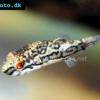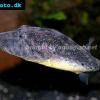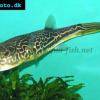Green pufferfish - Tetraodon nigroviridis
Scientific name: Tetraodon nigroviridis
Common name: Green pufferfish
Family: Tetraodontidae
Usual size in fish tanks: 10 - 17 cm (3.94 - 6.69 inch)
014
Recommended pH range: 7.5 - 8.5
Recommended water hardness: 12 - 18°N (214.29 - 321.43ppm)
0°C 32°F30°C 86°F
Recommended temperature range: 23 - 28 °C (73.4 - 82.4°F)
The way how these fish reproduce: Spawning
Where the species comes from: South Asia
Temperament to its own species: aggressive/territorial
Temperament toward other fish species: peaceful
Usual place in the tank: Bottom levels
Origin
The Green Pufferfish (Tetraodon nigroviridis) is native to coastal regions of Southeast Asia, specifically found in countries like Thailand, Vietnam, and Indonesia. These fish inhabit brackish estuaries, rivers, and coastal waters where freshwater and saltwater mix. As juveniles, they can thrive in freshwater environments, but as they mature, their need for brackish water increases. Some adult specimens may even prefer full marine conditions, depending on their individual needs. It’s important to monitor their behavior and gradually adjust the salinity of their tank to meet their requirements.
Short Description
The Green Pufferfish is a unique and captivating species to keep, but it does require specific care, especially as it matures. While juveniles can tolerate freshwater, they must be transitioned to brackish water and possibly even marine water as they grow older. These changes should be done gradually to avoid stress. Green Pufferfish are highly territorial and need ample space—each specimen should have at least 30 gallons (~136 liters, 36 US gallons) of water. They are also messy eaters, which means a strong filtration system is essential to maintain water quality. Additionally, they require hard foods like snails to wear down their continuously growing teeth. Without access to hard foods, their teeth can grow too long, leading to feeding difficulties.
Food and Feeding
Green Pufferfish are carnivorous and feed primarily on crustaceans, worms, snails, and krill. In the wild, they often prey on hard-shelled creatures, which help keep their teeth from overgrowing. In captivity, it's important to replicate this diet by providing hard-shelled foods like brine shrimp and Ramshorn snails. Ramshorn snails, in particular, are an excellent source of calcium and offer the necessary resistance to grind down the puffer’s teeth. It’s recommended to feed small, frequent meals throughout the day rather than two large meals, as this prevents overeating and digestive problems. Ensure that they are offered a variety of foods to meet their nutritional needs and reduce aggressive behavior.
Sexing
There are no easily distinguishable external features between male and female Green Pufferfish, making sexing difficult. Currently, there is no reliable way to differentiate males from females based on appearance alone.
Breeding
Breeding Green Pufferfish in captivity is possible but challenging due to their specific requirements and the high mortality rate of fry. When breeding occurs, the female lays her eggs on a hard surface like a rock or a secluded area of the aquarium. The male will guard the eggs by using his body to shield them from potential threats. The eggs hatch in approximately one week, and the fry can be fed on small live foods such as brine shrimp or microworms. As the fry grow, they can be introduced to small snails, such as baby Ramshorn snails, to support their development. The survival rate of fry can be low, so breeding success may require significant care and experience.
Lifespan
The Green Pufferfish can live for up to 15 years when provided with proper care, including high water quality, a nutritious and balanced diet, and a suitable habitat. Regular water changes, a strong filtration system, and monitoring of their dental health are essential to ensuring their long-term well-being.
Picture
Bought by aqua-fish.net from jjphoto.dk.
Video
About 44 MB, MPEG-1 format. Download this video here. Another vide is available after clicking here (about 28 MB).


 Red
Red  Striped
Striped  Malabar
Malabar  Amazon
Amazon  Red-spot
Red-spot  Bailey’s
Bailey’s  Thai
Thai  Figure
Figure  Fang’s
Fang’s  Green
Green  Coral
Coral  Giant
Giant  Congo
Congo  Humpback
Humpback  Mekong
Mekong  Bronze
Bronze